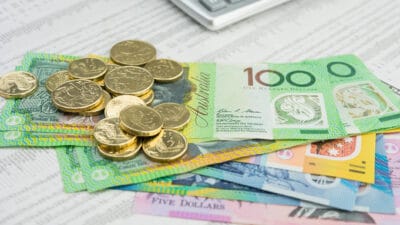The S&P/ASX 200 Index (ASX: XJO) share market seems like a great vehicle to drive our net worth towards being wealthy. Certainly, I'd much rather pick ASX 200 dividend shares over term deposits.
It's true that term deposits are now offering much better interest rates compared to 12 months ago.
Savers can now get very competitive rates on their savings. For example, when looking at term deposits from the big banks of Commonwealth Bank of Australia (ASX: CBA), National Australia Bank Ltd (ASX: NAB), Westpac Banking Corp (ASX: WBC), and ANZ Group Holdings Ltd (ASX: ANZ), we can now see a few term deposit percentage rates starting with a 4.
But, despite the much better interest rates, I think ASX 200 dividend shares are more likely to make us wealthy.
Stronger income compounding potential than term deposits
If I put $10,000 into a term deposit with an interest rate of 4%, in 12 months I'd receive $400 in interest.
To benefit from the power of compounding, I'd need to leave the $400 of interest with the bank and re-invest the $10,400 for another 12 months. At the end of year two, I'd be paid $416 of interest, leaving me with $10,816.
But, ASX 200 dividend shares can deliver more growth, in theory.
If I put $10,000 into an ASX 200 dividend share that had a share price of $10, I'd get 1,000 shares. If that business had an expected 4% dividend yield, I'd get $400 in dividends after the first year. I could re-invest the dividend and let's say I could buy another 40 shares (probably using a dividend re-investment plan), leaving me with 1,040 shares if the share price is still $10.
Let's say that when the company reported its next full-year result it decided to grow the dividend by 10% after achieving earnings growth, resulting in $440 from my original 1,000 shares and $17.60 from my extra 40 shares, meaning a total of $457.60 of income paid in year two.
Assuming the share price didn't change, my original $10,000 investment has turned into $10,858.
It's the ability of a company to grow the dividend alongside earnings that can supercharge passive income combined with re-investment, rather than simply relying on re-investing the income each year.
Of course, it's not just income that makes up the returns of ASX 200 dividend shares. Capital growth is a big part of the picture.
Capital growth adds to returns
Let's use the biggest ASX exchange-traded fund (ETF) as an example. The Vanguard Australian Shares Index ETF (ASX: VAS) tracks the S&P/ASX 300 Index (ASX: XKO), which is very similar to the ASX 200 and owns many of the same ASX 200 dividend shares.
Since the ETF's inception in May 2009, the fund has produced an average return per annum of 9.21%. Around half of that was from income – an average of 4.64% per annum, more than the dividend yield in my above example – and half of the total return was from capital growth. This shows how the ASX as a whole has performed, and the split of returns.
We don't know what share prices are going to do this month or this year. But, if earnings keep growing then I think ASX 200 dividend shares give themselves a great chance of growing the share price (and the dividend payout).
Which ASX 200 dividend shares to buy?
I like the look of businesses that are capable of producing long-term earnings growth and dividend growth. For example, in this article, I mentioned Washington H. Soul Pattinson and Co. Ltd (ASX: SOL), Brickworks Limited (ASX: BKW), Sonic Healthcare Ltd (ASX: SHL), and APA Group (ASX: APA) and I also cover Wesfarmers Ltd (ASX: WES) shares sometimes.
I believe these are the sorts of names that can make better income returns and total than term deposits.









